Introduction: Who this guide is for
If you’re a creator, founder, or marketer torn between launching a newsletter fast with zero fuss or building a long-term, SEO-friendly content brand, this Ghost vs Substack guide is for you. We’ll keep things practical: quick answers, a crisp comparison table, and clear recommendations by goal. Whether you care most about simplicity, brand control, SEO visibility, or scaling paid newsletters, you’ll know exactly where each platform shines.
Prefer an all-in-one route with a blog plus newsletter baked in, SEO-first templates, and heavy AI automation? BlogBowl helps SaaS teams and startups launch a professional, fast blog with integrated newsletters and analytics in under a minute - plus automated keyword research, internal linking, and daily AI articles - so you can focus on content while growth runs on autopilot. Learn more at https://www.blogbowl.io.
Ghost vs Substack at a Glance (quick answers)
TL;DR:
Substack = the simplest start, built-in network effects, 10% platform fee.
Ghost = full brand control, stronger SEO options, 0% fee on revenue, slightly more setup.
Quick picks by goal:
Hobby/experiment: Substack
Brand-building (own your design, domain, and UX): Ghost
SEO traffic (technical SEO controls, fast pages): Ghost
Monetizing memberships at scale (keep more revenue): Ghost
Minimal tech skills / fastest launch: Substack
Migrating from Substack while keeping ownership: Ghost
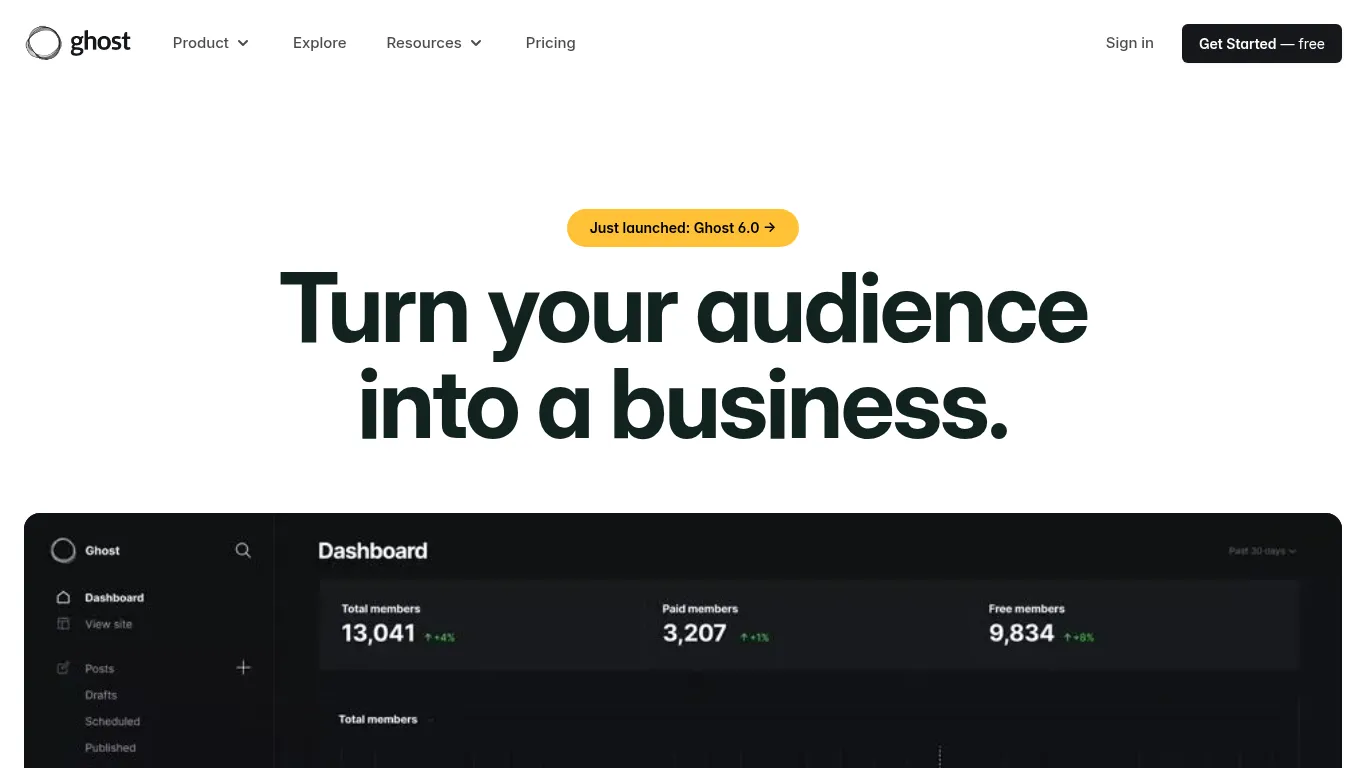
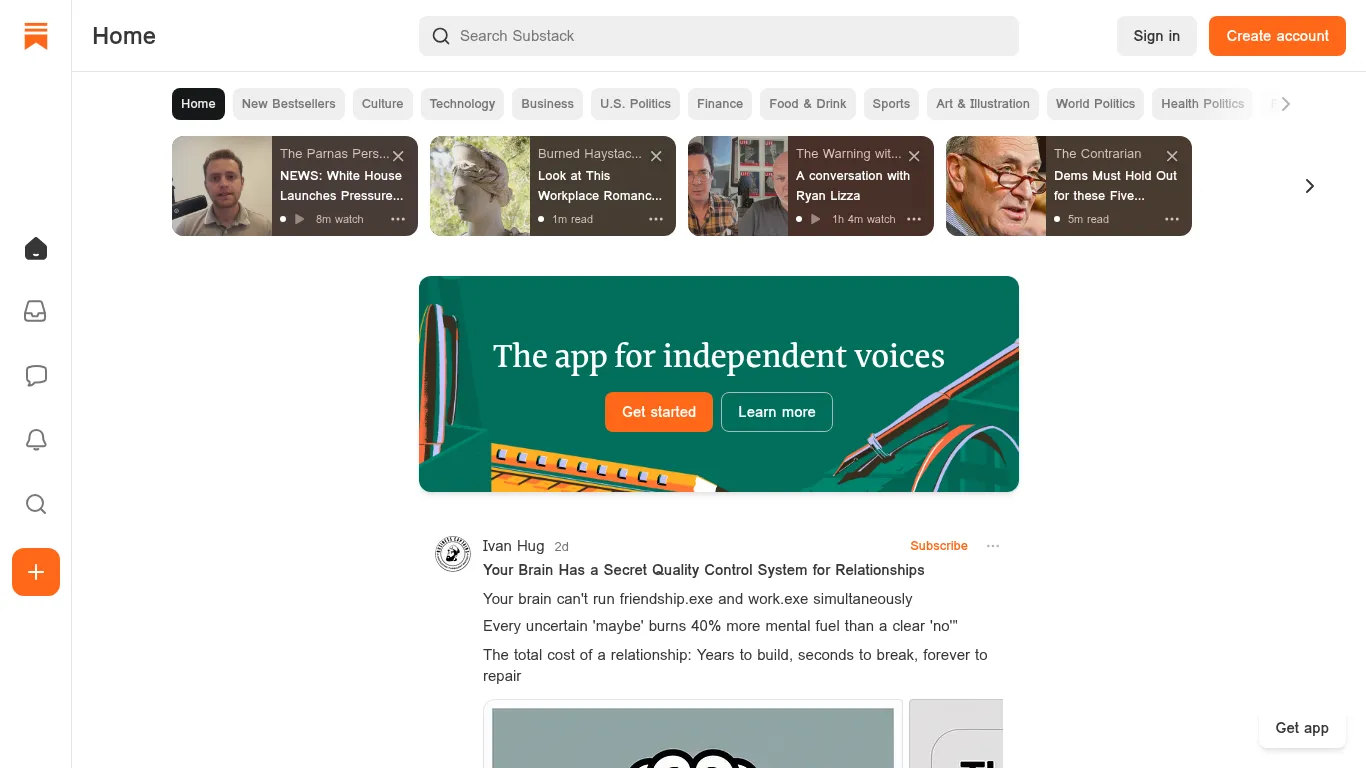
Comparison Table (core differences)
Feature | Ghost | Substack |
|---|---|---|
Primary focus | Professional publishing, blog + newsletter + memberships | Simple newsletter publishing with built-in network |
Pricing model | Fixed subscription (hosting/plan fees) | Free to start; 10% revenue share on paid subs |
Transaction fees | 0% (standard payment processor fees still apply) | 10% platform fee + processor fees |
Customization | Extensive themes, code access, custom domains/layouts | Limited design; basic branding controls |
SEO controls | Strong technical SEO (URLs, metadata, sitemaps, speed) | Basic SEO; fewer technical controls |
Growth/discovery | Independent growth (your brand, your site) | Platform discovery via recommendations/network |
Automations | Flexible via integrations and workflows | Limited native automation |
Analytics | Site + member analytics; extensible via integrations | Basic newsletter analytics |
Integrations | Broad ecosystem (native + no-code tools) | Minimal integrations |
Ownership/portability | Full ownership of site, data, and branding | Own content and list; platform constraints remain |
Best for | Brand builders, SEO-focused creators, scaling memberships | Beginners, hobbyists, rapid experiments |
Suggested video (single YouTube)
A neutral, up-to-date walkthrough comparing Ghost vs Substack for creators in 2025:
Pricing models explained
Substack: Free to start. When you enable paid subscriptions, Substack takes a 10% platform fee on each transaction. Stripe processing fees apply to every successful charge. There’s also an optional one-time $50 fee for using a custom domain.
Ghost: Fixed monthly or annual Ghost(Pro) hosting with 0% platform fee on revenue. Stripe processing fees still apply. You can also self-host Ghost if you prefer to manage infrastructure yourself.
"Stripe’s standard processing fee for domestic online card transactions in the U.S. is 2.9% + $0.30 per successful charge." - Source
"Publishing free content is free, but enabling paid subscriptions incurs a 10% Substack platform fee (plus Stripe fees)." - Source
Break-even math (year 1 and beyond)
Below shows how a percentage-based fee (Substack) scales with revenue compared to a fixed-cost model (Ghost). Assumes an illustrative Ghost(Pro) fixed cost of $348/year and excludes Stripe fees since they apply to both.
ARR from Paid Subs | Substack Platform Fee (10%) | Ghost Fixed Cost (Annual) | Platform Cost Delta (Substack − Ghost) | More Cost-Efficient |
|---|---|---|---|---|
$10,000 | $1,000 | $348 | $652 | Ghost |
$50,000 | $5,000 | $348 | $4,652 | Ghost |
$100,000 | $10,000 | $348 | $9,652 | Ghost |
Key takeaway: As ARPU and paid member counts rise, Ghost’s fixed-cost model becomes dramatically cheaper than a 10% revenue share.
Non-obvious costs
Time-to-launch tradeoff: Substack is the fastest way to collect emails and charge subscribers; Ghost takes a little more setup but pays off at scale.
Substack custom domain: Optional one-time $50 fee.
Ghost themes: Premium themes (optional) can add cost; many free themes exist.
Deeper customization on Ghost: May require developer/design help if you want heavy code-level changes.
Quick guidance
If monetization is uncertain: Substack’s no-upfront-cost model is attractive while you validate demand.
If monetization is expected to grow: Ghost’s 0% platform fee and fixed TCO usually win at scale.
SEO control and site architecture
Ghost gives you highly granular SEO control out of the box: custom URLs, meta titles/descriptions, canonical tags, XML sitemaps, robots rules, redirects, and structured data. Its themes are fast and lightweight, and you can fully shape your site’s information architecture (collections, pages, hubs, and topic clusters) for topical authority.
Substack covers the basics and supports custom domains (with a fee), but key technical controls (like redirects) are limited. Its network-first model and constrained page structure make it harder to build deep content architectures and evergreen hubs that compound search traffic over time.
"Ghost includes built-in SEO features such as customizable meta tags, canonical URLs, automatic XML sitemaps, structured data (JSON‑LD), OpenGraph/Twitter cards, and a generated robots.txt." - Source
Discovery models
Substack: Growth is baked into the platform via internal recommendations, Notes, and the broader network. This can help with early distribution and list-building, but you’ll have less control over your long-term SERP footprint and site architecture.
Ghost: SEO-first publishing where discovery primarily comes from search engines and social channels. You’ll build and own your distribution flywheel - content hubs, interlinking, and newsletter lead capture on your own domain.
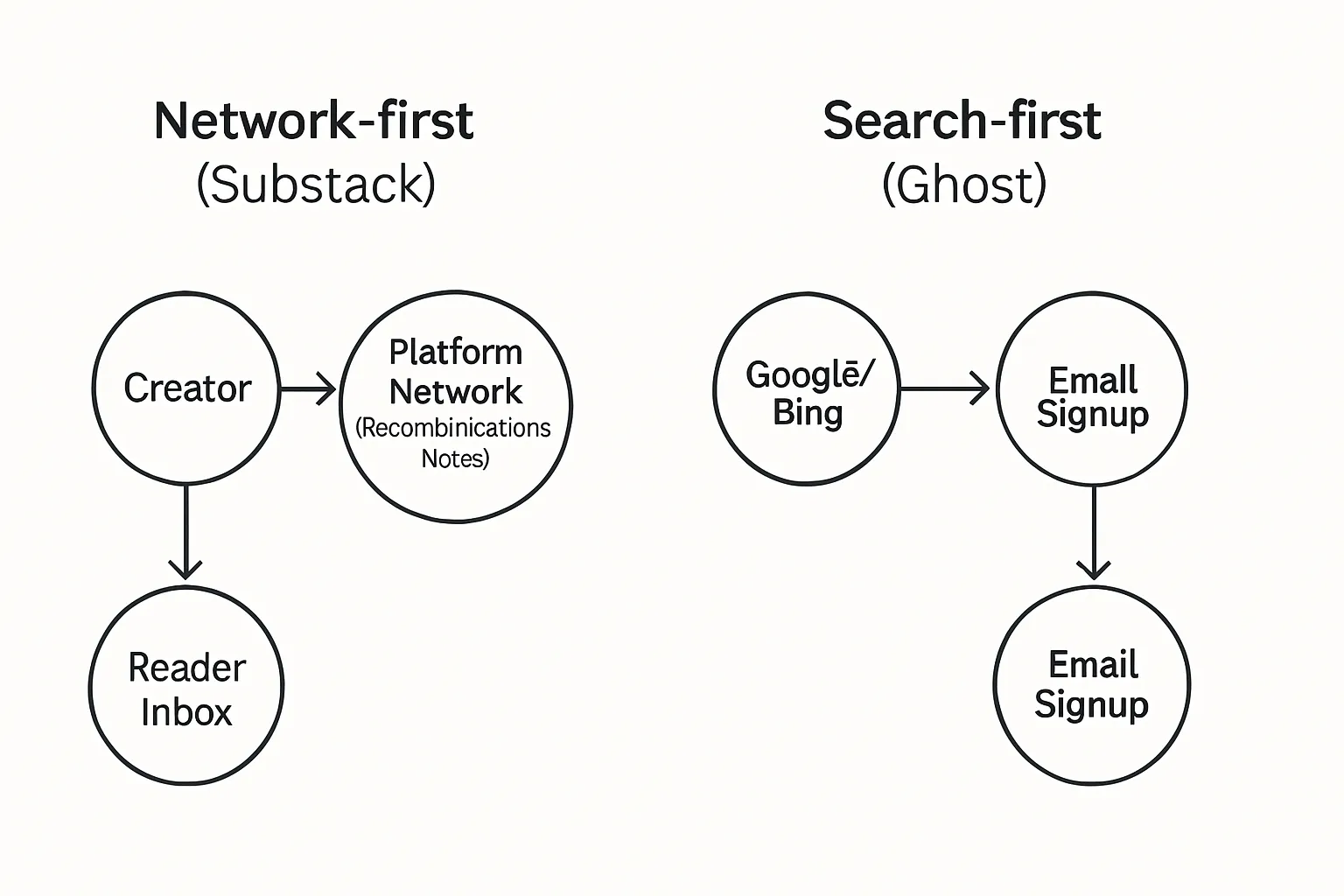
When SEO is mission-critical
Choose Ghost if your strategy depends on long-term organic traffic, building topical authority, and creating content hubs that rank and compound. Substack is strong for immediate, low-friction distribution via its network; Ghost is built to win sustained visibility in search.
Visual identity and theme control
Ghost: If you care about brand distinctiveness, Ghost is built for it. You get a full theme marketplace, access to the entire theme code, and code injection for advanced tweaks. Create custom components (cards, blocks, sections), remove platform branding, and shape flexible page structures (collections, hub pages, pillar + cluster content) so your publication looks and feels uniquely yours.
Substack: Designed for speed and consistency. You’ll get minimal design options, a standard layout, and platform branding that appears across many surfaces. The simple, uniform UX is great for getting content out fast, but it limits how far you can push a bespoke brand experience.
Domains and email branding
Ghost: Use a custom domain on all paid plans and fully brand your email templates - colors, typography, header/footer elements - so newsletters feel like a seamless extension of your site.
Substack: Custom domains are available with a one-time fee, but email template control is limited. You can match basics (logo, accent color), yet your messages will still resemble the standard Substack look.
Who benefits most
Choose Ghost if you’re building a distinctive brand or media property and want total control over design, structure, and presentation. It’s ideal for creators who see their publication as a long-term asset that must look and feel proprietary.
Choose Substack if you prioritize speed over uniqueness. It’s a great fit for writers who want to publish consistently, share updates quickly, and avoid design decisions while still benefiting from a familiar UX.
Editor experience
Ghost: A block-based editor with rich embeds, custom HTML/CSS/JS (where allowed), and reusable content blocks for faster production. You can also run multiple newsletters under one site - great for segmenting topics while keeping a unified brand.
Substack: A minimalist, distraction-free editor with fewer block types. It’s intentionally simple, so you can focus on words and hit publish without fiddling with layout.
Email capabilities
Ghost: Segment audiences, use basic automations via integrations, and customize your email design. Flexible sending options help you target by member tiers, interests, or cohorts.
Substack: Straightforward newsletter sending with limited segmentation and no native multi-step automations. It’s built for clarity over complexity.
Collaboration & workflow
Ghost: Roles and permissions support teams. Organize content into collections, and extend editorial workflows with integrations for briefs, edits, and approvals.
Substack: Simple solo-writer workflows with easy co-authors and guest posts - ideal for lean operations.
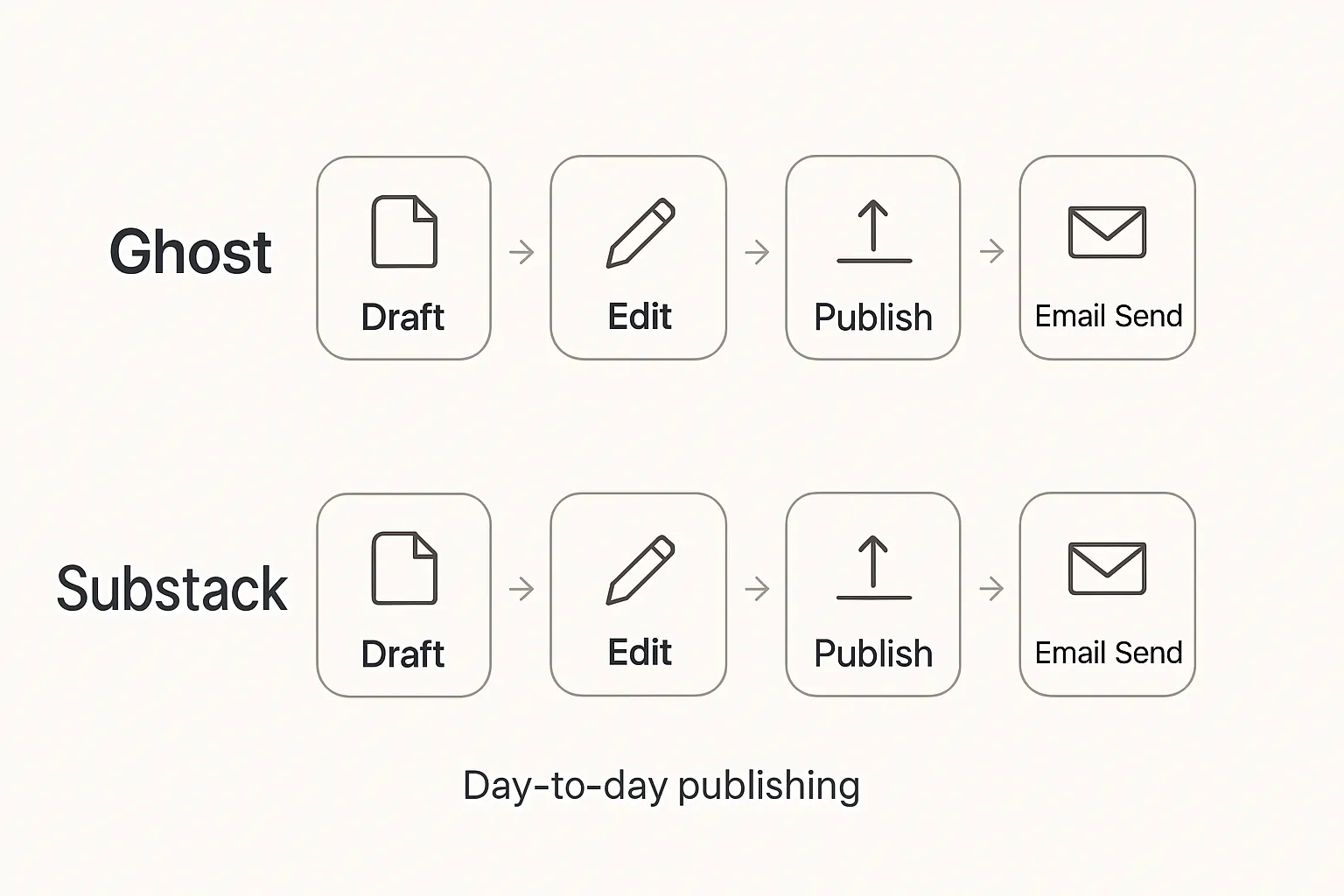
Built-in growth levers
Substack: Growth is network-driven. Recommendations, Notes, and native comments create distribution loops that can accelerate early list growth - especially for newcomers without existing audiences. It’s low-friction to get discovered by readers already inside the platform.
Ghost: Growth is owned-channel-first. The Explore directory can help, but most momentum comes from SEO, social, partnerships, and referral programs you wire up via integrations. The upside: you build durable traffic assets on your own domain instead of relying on a platform’s feed.
Community & feedback loops
Substack: Native comments, likes, and replies make it easy to spark conversation. Readers are used to interacting in-thread, so you get a lightweight but effective sense of community with no extra setup.
Ghost: Comments typically come via integrations (or membership-only spaces), which gives you flexibility to create deeper communities using external tools (forums, Discord, Circle, etc.). You control the experience and access, but it takes more configuration.
Deliverability & list health
Sender reputation: Consistent sending cadence, clean list hygiene (sunset inactive contacts), and clear permission practices matter on both platforms.
Custom sending domains: Ghost supports custom sending domains and branding, which can help with domain reputation and inbox placement over time when set up correctly (SPF, DKIM, DMARC).
Quality signals: Segmenting by engagement, using relevant subject lines, and trimming chronically inactive subscribers improves deliverability on any newsletter platform.
Core monetization models
Substack: Paid subscriptions are the centerpiece, but the platform takes a 10% fee on paid revenue. Sponsorships are typically handled manually, with limited native ad tooling and no built-in cart for selling digital products.
Ghost: Paid memberships with 0% platform fee. Add display ads via integrations, line up sponsors/affiliates, and extend with storefront add-ons for digital products or courses - more flexibility to diversify revenue.
Payout flows & ownership
Both platforms connect to Stripe, so your payments and customer data remain portable. The key difference is economics at scale: Ghost’s fixed platform cost and 0% fee mean your margins improve as revenue grows, while Substack’s revenue share scales with your success.
Upsell opportunities
Ghost’s site structure supports dedicated landing pages, productized content, and tiered member experiences - making it easier to create upgrades and bundles. Substack focuses on a single newsletter stream with paywalls, which is simpler but offers fewer native surfaces to upsell.
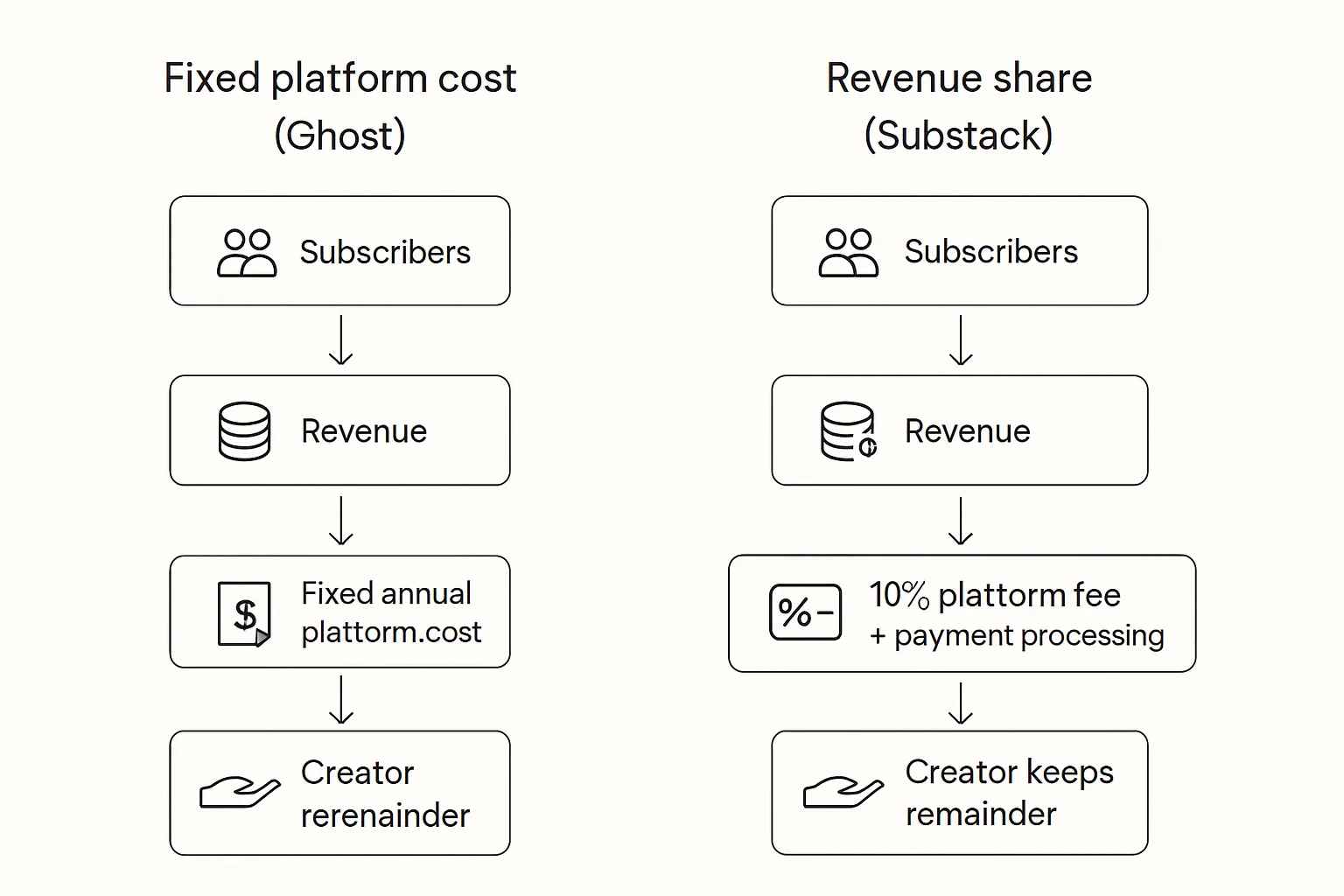
Moving from Substack → Ghost
Export your posts and subscribers from Substack.
Import into Ghost using the built-in importer.
Sanity checks:
Redirects: map old URLs to new slugs where possible.
Design: apply a starter theme, then refine layout and components.
Email: connect Stripe, set sender domain (SPF/DKIM/DMARC), send test campaigns.
Moving from Ghost → Substack
Export content and your subscriber list from Ghost.
Rebuild structure within Substack’s simpler layout (expect fewer page types).
Accept tradeoffs: limited customization, fewer SEO controls, and revenue share on paid subs.
Data ownership & platform risk
Ghost: Open-source and portable. You can self-host for maximum control, or use hosted Ghost while retaining exportability of content and members.
Substack: You own your content and list exports, but the platform sets features and policies; customization and technical controls remain limited.
Launch checklist (for either path)
DNS/domain setup and SSL
Branding (logo, colors, typography)
Starter theme activated and tuned
Email sending tests (list segments, design checks)
Analytics connected and verified
Publish first 3–5 pillar pieces to seed discovery

If you are…
The experimenter/hobbyist: Start on Substack to validate your idea quickly and for free. It’s the lowest-friction way to publish and gather early subscribers without upfront costs.
The brand builder/media operator: Choose Ghost for control, customization, SEO, and scalable economics. You’ll own your domain, design, and data - and keep 100% of subscription revenue (payment processor fees aside).
The SEO-focused educator: Ghost wins for topic clusters, semantic hubs, custom URL structures, and internal linking that compounds. Ideal for building a durable content moat beyond a single newsletter feed.
The solo writer who wants network effects: Substack is great for built-in recommendations, Notes, and platform discovery - especially if you’re starting from scratch and want fast distribution loops.
The SaaS/startup content team: Choose Ghost for full brand control and content architecture (blog + hub pages + members), or consider BlogBowl if you want AI-driven content ops, daily SEO articles, and an all-in-one blog + newsletter that’s SEO-first.
Decision tree (textual walk-through)
Need to publish today with zero setup and no upfront cost?
Pick Substack.
Expect paid subscribers to grow and want to keep platform fees at 0%?
Pick Ghost.
Is long-term SEO, topical authority, and a content hub strategy central to your growth?
Pick Ghost.
Do you value discovery inside a platform (recommendations/Notes) more than fine-grained control?
Pick Substack.
Do you need custom themes, site structure, and a distinctive brand experience?
Pick Ghost.
Running a SaaS/startup and want an automation-heavy, SEO-first blog + newsletter with minimal lift?
Consider BlogBowl for an AI-powered, all-in-one publishing stack.
Bottom line
Substack: Unbeatable for a zero-friction start and simple paid newsletters. It’s perfect for testing an idea, publishing quickly, and tapping into built-in recommendations and Notes.
Ghost: Best for long-term brand equity, SEO, and keeping 100% of revenue (aside from payment processing). If you want full control over design, structure, and economics, Ghost is the winner.
Strategic nudge (fair, transparent)
Start on Substack to validate your concept and grow an initial list with minimal effort. Once revenue grows or brand/SEO become strategic priorities, move to Ghost to own your platform, expand customization, and remove the 10% platform fee on paid newsletters.
Where BlogBowl fits
If you need a fast, SEO-optimized blog with an integrated newsletter - and you want AI to automate ideation, drafting, internal linking, and publishing - consider BlogBowl. It’s built for SaaS and growth teams who want an all-in-one, SEO-first engine without the overhead of plugins, dev work, or manual content ops.
Next steps
Validate with Substack for a quick, free launch.
Pilot Ghost(Pro) once you prove demand or need deeper branding/SEO control.
Spin up BlogBowl to run a high-velocity, SEO-first blog and newsletter with AI doing the heavy lifting across research, writing, and publishing.


